Q2 Metals Extends Mineralized Zone Strike Length to 1.5 Kilometres and Concludes the 2025 Winter Program at the Cisco Lithium Project in Quebec, Canada
Q2 Metals (QUEXF) has completed its 2025 Winter Program at the Cisco Lithium Project in Quebec, with 6,997 meters drilled across 14 holes. Key highlights include extending the mineralized zone strike length to 1.5 kilometers (previously 850m) and significant spodumene pegmatite intersections:
- Drill hole CS25-028: Eight intervals with continuous spans of 50.9m, 21.5m, and 19.3m
- Drill hole CS25-036: Thirteen intervals with spans of 64.3m, 22.3m, 18.1m, and 12.7m (ended in pegmatite at 308.6m)
The company has dispatched samples for assaying, with first results expected in May. Additional metallurgical testing is underway at SGS Canada to evaluate beneficiation potential, aiming to produce spodumene concentrate of >6% Li2O. The Cisco Project, located 150km from rail access in James Bay, Quebec, has shown promising 2024 discovery results including intersections of 120.3m at 1.72% Li2O and 215.6m at 1.69% Li2O.
Q2 Metals (QUEXF) ha completato il Programma Invernale 2025 presso il progetto Cisco Lithium in Quebec, con 6.997 metri perforati in 14 fori. Punti salienti includono l’estensione della lunghezza della zona mineralizzata a 1,5 chilometri (precedentemente 850m) e significative intersezioni di pegmatite di spodumene:
- Foro di perforazione CS25-028: otto intervalli con spessori continui di 50,9m, 21,5m e 19,3m
- Foro di perforazione CS25-036: tredici intervalli con spessori di 64,3m, 22,3m, 18,1m e 12,7m (terminato in pegmatite a 308,6m)
L’azienda ha inviato i campioni per le analisi, con i primi risultati attesi per maggio. Sono in corso ulteriori test metallurgici presso SGS Canada per valutare il potenziale di arricchimento, con l’obiettivo di produrre un concentrato di spodumene con >6% di Li2O. Il progetto Cisco, situato a 150 km dall’accesso ferroviario nella Baia di James, Quebec, ha mostrato promettenti risultati di scoperta nel 2024, inclusi intervalli di 120,3m a 1,72% Li2O e 215,6m a 1,69% Li2O.
Q2 Metals (QUEXF) ha completado su Programa de Invierno 2025 en el Proyecto Cisco Lithium en Quebec, con 6.997 metros perforados en 14 pozos. Aspectos destacados incluyen la extensión de la longitud de la zona mineralizada a 1,5 kilómetros (antes 850m) y significativas intersecciones de pegmatita de espodumena:
- Pozo CS25-028: ocho intervalos con tramos continuos de 50,9m, 21,5m y 19,3m
- Pozo CS25-036: trece intervalos con tramos de 64,3m, 22,3m, 18,1m y 12,7m (terminó en pegmatita a 308,6m)
La compañía ha enviado muestras para análisis, con los primeros resultados esperados en mayo. Se están realizando pruebas metalúrgicas adicionales en SGS Canadá para evaluar el potencial de beneficio, con el objetivo de producir un concentrado de espodumena con >6% de Li2O. El Proyecto Cisco, ubicado a 150 km del acceso ferroviario en James Bay, Quebec, ha mostrado resultados prometedores en su descubrimiento de 2024, incluyendo intersecciones de 120,3m a 1,72% Li2O y 215,6m a 1,69% Li2O.
Q2 Metals (QUEXF)는 캐나다 퀘벡의 Cisco Lithium 프로젝트에서 2025년 겨울 프로그램을 완료했으며, 14개의 시추공에서 총 6,997미터를 시추했습니다. 주요 성과로는 광화대 연장 길이를 1.5킬로미터(이전 850m)로 확대하고, 중요한 스포듐 광맥 교차 구간이 포함됩니다:
- 시추공 CS25-028: 50.9m, 21.5m, 19.3m의 연속 구간을 포함한 8개 구간
- 시추공 CS25-036: 64.3m, 22.3m, 18.1m, 12.7m 구간을 포함한 13개 구간 (308.6m 지점에서 광맥 종료)
회사는 분석을 위해 시료를 발송했으며, 첫 결과는 5월에 나올 예정입니다. 추가로 SGS 캐나다에서 선광 가능성을 평가하기 위한 야금학적 테스트가 진행 중이며, Li2O 6% 이상의 스포듐 농축물 생산을 목표로 하고 있습니다. 제임스 베이 퀘벡의 철도 접근 지점에서 150km 떨어진 Cisco 프로젝트는 2024년 발견 결과로 120.3m 구간에서 1.72% Li2O, 215.6m 구간에서 1.69% Li2O의 유망한 교차 구간을 보였습니다.
Q2 Metals (QUEXF) a terminé son programme hivernal 2025 au projet Cisco Lithium au Québec, avec 6 997 mètres forés sur 14 trous. Points clés : extension de la longueur de la zone minéralisée à 1,5 kilomètre (contre 850 m auparavant) et intersections significatives de pegmatite de spodumène :
- Trou de forage CS25-028 : huit intervalles avec des longueurs continues de 50,9 m, 21,5 m et 19,3 m
- Trou de forage CS25-036 : treize intervalles avec des longueurs de 64,3 m, 22,3 m, 18,1 m et 12,7 m (fin en pegmatite à 308,6 m)
La société a envoyé des échantillons pour analyse, avec les premiers résultats attendus en mai. Des tests métallurgiques supplémentaires sont en cours chez SGS Canada pour évaluer le potentiel de valorisation, visant à produire un concentré de spodumène avec plus de 6 % de Li2O. Le projet Cisco, situé à 150 km de l’accès ferroviaire à James Bay, Québec, a présenté des résultats prometteurs en 2024, incluant des intersections de 120,3 m à 1,72 % Li2O et 215,6 m à 1,69 % Li2O.
Q2 Metals (QUEXF) hat sein Winterprogramm 2025 beim Cisco Lithium Projekt in Quebec abgeschlossen und dabei 6.997 Meter in 14 Bohrlöchern niedergebracht. Wichtige Highlights umfassen die Verlängerung der mineralisierten Zone auf 1,5 Kilometer (vorher 850m) sowie bedeutende Spodumen-Pegmatit-Schnitte:
- Bohrloch CS25-028: Acht Intervalle mit durchgehenden Längen von 50,9m, 21,5m und 19,3m
- Bohrloch CS25-036: Dreizehn Intervalle mit Längen von 64,3m, 22,3m, 18,1m und 12,7m (Ende im Pegmatit bei 308,6m)
Das Unternehmen hat Proben zur Analyse verschickt, erste Ergebnisse werden im Mai erwartet. Weitere metallurgische Tests laufen bei SGS Canada, um das Aufbereitungspotenzial zu bewerten, mit dem Ziel, Spodumenkonzentrat mit >6% Li2O zu produzieren. Das Cisco-Projekt, 150 km vom Schienenanschluss in James Bay, Quebec, entfernt, zeigte vielversprechende Entdeckungsergebnisse aus 2024 mit Schnitten von 120,3m bei 1,72% Li2O und 215,6m bei 1,69% Li2O.
- Nearly doubled mineralized zone strike length from 850m to 1.5km
- Significant spodumene pegmatite intersections in multiple drill holes
- Strategic location with rail access 150km away
- Project remains open in all directions and at depth
- Strong 2024 discovery results with high-grade lithium intersections
- Assays still pending for all 14 drill holes
- Hole CS25-036 ended prematurely due to time constraints
- Less than 10% of total land package explored to date
Highlights:
The 2025 Winter Program concluded with 6,997 metres (m) drilled across 14 holes.
Drill hole CS25-028 encountered eight (8) spodumene pegmatite intervals, with the widest interval of 50.9 m of continuous spodumene pegmatite, along with additional noteworthy intercepts of 21.5 m and 19.3 m.
Drill hole CS25-036 encountered 13 spodumene pegmatite intervals, with the widest interval of 64.3 m of continuous spodumene pegmatite, along with additional noteworthy intervals of 22.3 m, 18.1 m and 12.7 m. Hole 36 ended in pegmatite at a depth of 308.6 m due to time constraints.
Assays are pending on all 14 drill holes completed in the 2025 Winter Program.
The northeast-southwest strike of the main zone has increased to 1,500 m (previously 850 m at the end of 2024).
VANCOUVER, BC / ACCESS Newswire / April 28, 2025 / Q2 Metals Corp. (TSX.V:QTWO)(OTCQB:QUEXF)(FSE:458) ("Q2" or the "Company") is pleased to provide an update on the Winter 2025 expansion drill program ("2025 Winter Program") at the Company's Cisco Lithium Project (the "Project" or the "Cisco Project"), located within the greater Nemaska traditional territory of the Eeyou Istchee James Bay, Quebec, Canada.
The 2025 Winter Program at the Cisco Project concluded with a total of 14 drill holes for 6,997 m of drilling completed. Of the 14 drill holes completed, 10 intercepted spodumene-bearing pegmatite. Assays are pending on all 14 drill holes, and the Company anticipates the first results to be announced in May.
"We are very encouraged by the results to date, which continue to validate the scale and potential of the Cisco Project," said Q2 Metals President and CEO Alicia Milne. "With only 37 holes drilled for 14,644 metres to date, we've built a strong foundation for continued advancement. Cisco's strategic position in the southernmost part of the Eeyou Istchee James Bay region, just 150 kilometres from rail access, gives it a distinct development advantage and further enhances the project's long-term value. We remain well-funded, the project remains open in all directions and at depth, and we are eager to resume drilling in June."
"The 2025 Winter Program was highly successful," said Q2 Vice President of Exploration Neil McCallum. "During the program we nearly doubled the strike length of the main mineralized zone from 850 m to 1.5 kilometres and started to drill test other areas of interest that will require further work. On our return to the Project in June, we will continue to systematically define the known mineralized zone, starting with Hole 36 which ended due to the start of the traditional goose hunting season at 308.6 m and in spodumene pegmatite. Additional mapping and sampling of the Cisco Project will also be a priority this summer as we've explored less than 10 percent of our total land package, leaving a significant amount of the prospective 30-kilometre-long greenstone belt still to be tested."
Summary of Spodumene-Bearing Pegmatite Intervals
The pegmatite intervals (greater than 2 m) of drill holes CS-25-028 to 37 are reported below in detail (Table 1 & 2):
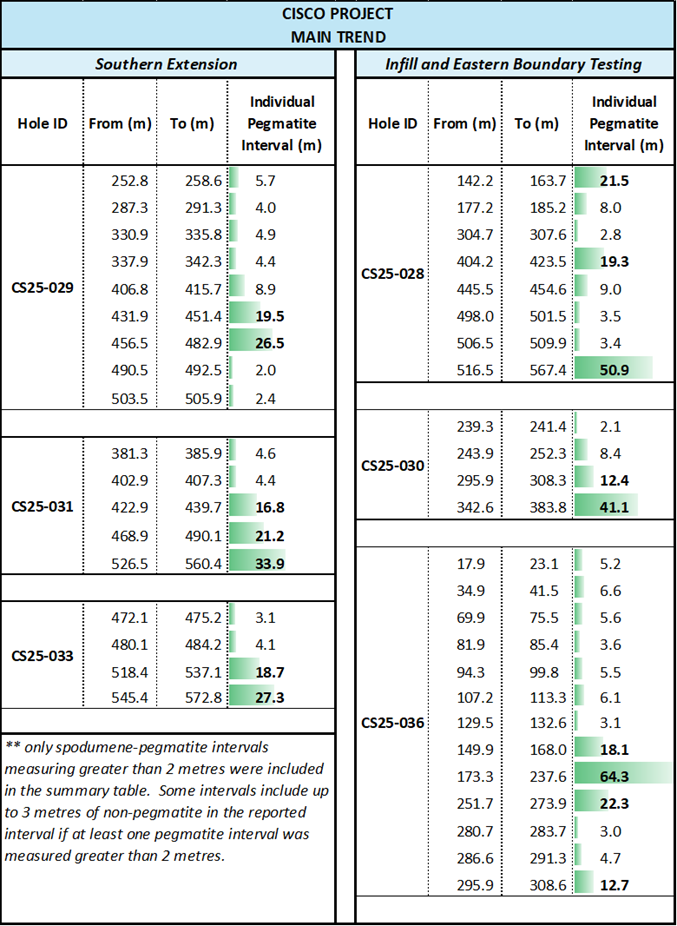
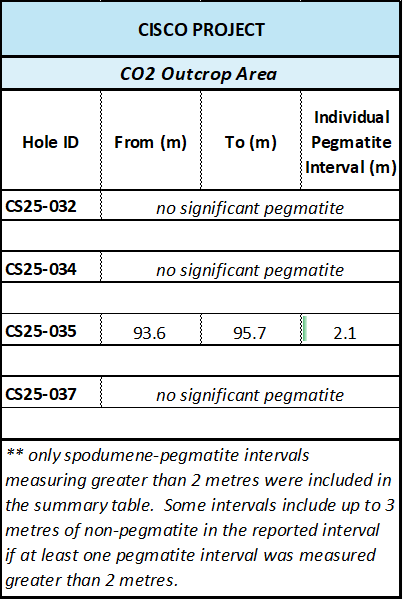
The mineralized intervals in all the holes are not necessarily representative of the true width and the modelled pegmatite zones are being refined with every additional hole.
Cautionary Statement: The presence of pegmatites does not confirm the presence of lithium (spodumene or other lithium minerals). Pegmatites are fractionated coarse grained igneous rocks commonly associated with lithium mineralization; however, many pegmatites do not contain mineralization. The presence of any mineralization can only be confirmed with assaying.
The geological team has completed the core cutting and logging of holes CS25-028 to CS25-037 and the samples have been dispatched to the SGS Canada preparation laboratory located in Val-d'Or, QC for mineral analysis to confirm the presence of lithium.
Discussion of Drilling Results
Three holes (CS25-029, 031 and 033) targeted the southern extension of the main mineralized zone. With the 200-metre spacing, and only a few holes per section line, wide (>100 metre) pegmatite intervals were not intercepted. It is expected that the wide pegmatite intervals are present, however additional testing work is required. It is noted that the pegmatite intervals are somewhat deeper in the drill holes at the south and further work will be carried out during the summer exploration season to test the potential up-dip location of the pegmatite towards the west. In summary, the main zone remains open to the south.
Hole CS25-030 targeted the deeper portions of the northern extent of the main mineralized zone and has demonstrated that the zone is open in that direction.
Hole CS25-028 tested the eastern portion of the main mineralized zone and provided additional information in that area. Combined with the other holes drilled to the east, the zone remains open in that direction as well.
Hole CS25-036 was not completed prior to the start of this year's goose-hunting season and ended before the intended completion depth. Despite this, the objective of the hole was accomplished with several wide pegmatite intervals intercepted that will assist in resolving the geometry of the pegmatite as well as providing guidance on definition-scale drilling. Drilling on this hole will re-commence as soon as possible after the goose-hunting season.
Drill holes CS25-032, 034, 035 and 037 were drilled to define the subsurface expression of the prominent mineralized CO2 outcrop. Additional work is needed to follow up this area as several potential orientations have not yet been tested.
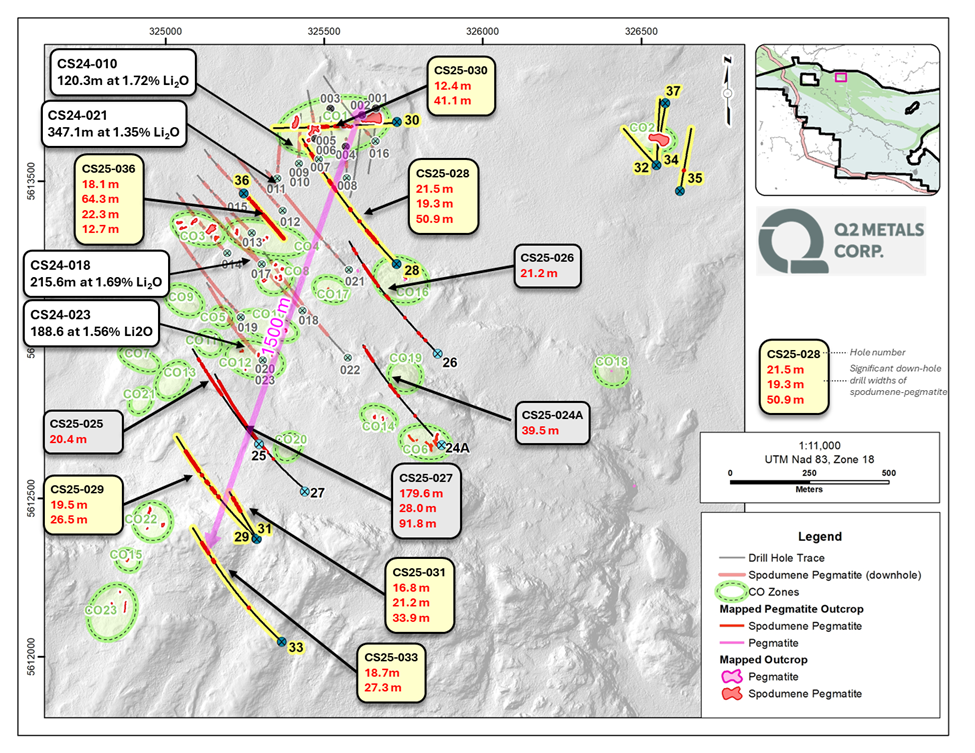

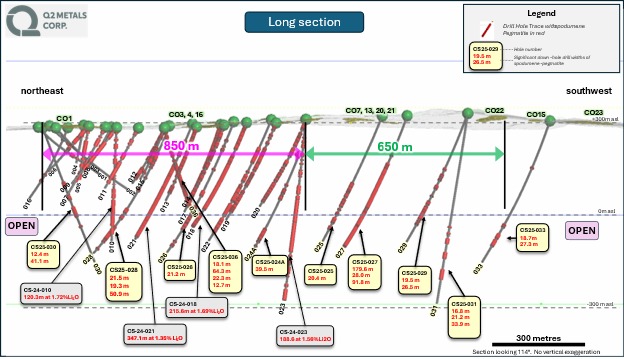
Metallurgical Testing
During the 2025 Winter Program, representative samples were assembled and dispatched to SGS Canada for additional preliminary metallurgical test work, including heavy liquid separation (HLS), dense media separation (DMS), magnetic separation, and flotation.
The primary objective of the preliminary metallurgical program will be to evaluate the beneficiation of the currently defined mineralized zone at the Cisco Project with a traditional lithium pegmatite flowsheet. The goal of the proposed metallurgical work is to produce a spodumene concentrate of greater than
Initial metallurgical testing on 16 drill core analytical pulp samples of pegmatite collected across seven (7) drill holes at the Cisco Project indicated that spodumene is the primary lithium-bearing mineral within all pegmatite samples (see news release from Q2 on February 12, 2025).
Optical Televiewer Survey Work
During the 2024 drill program conducted at the Cisco Project, optical televiewer survey work was conducted on 13 of the 17 holes drilled by the Company to confirm the pegmatite contact relationships at depth (see news release from the Company on February 3, 2025).
Following the compilation and review of the data points collected, it was determined that the orientation of the pegmatite aligns with the surface measurements, and that the drill azimuth is appropriate for this stage of the Company's drilling campaigns. Additionally, the dip of the pegmatite varies between 25- and 80- degrees (relative to the surface), indicating that the current drill angle of -45 degrees is the most appropriate angle.
The Company continued to collect downhole televiewer data during the 2025 Winter Program. Additional drill holes from the 2024 drill program were surveyed as well as several of the holes drilled in the 2025 Winter Program (drilling at hole CS25-036 was in process). Data collected will continue to refine the Company's most appropriate drilling approach.
Sampling, Analytical Methods and QA/QC Protocols
All drilling was conducted using diamond drill rig with NQ sized core and all drill core samples are shipped to SGS Canada's preparation facility in Val D'Or, Quebec, for standard sample preparation (code PRP92) which includes drying at 105°C, crushing to
A Quality Assurance / Quality Control (QA/QC) protocol following industry best practices was incorporated into the sampling program. Measures include the systematic insertion of quartz blanks and certified reference materials (CRMs) into sample batches at a rate of approximately
Drill Hole Collar Information
The summary of drill holes completed to date, including basic location and dip/azimuth is detailed below (Table 3):
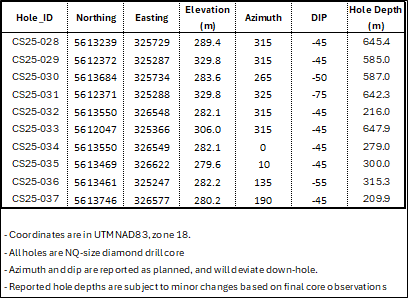
Upcoming Events
121 Mining Investment Conference
Q2 Metals will be attending the 121 Mining Investment Conference in London, UK from May 12-13, 2025. For more information, click here.
Canaccord Genuity Global Metals & Mining Conference
The Company will be attending the Canaccord Genuity Global Metals & Mining Conference in Henderson, NV from May 20-22, 2025. For more information, click here.
THE Mining Event of the North
Q2 will be attending and exhibiting at THE Mining Event of the North in Quebec City, QC from June 3-5, 2025. For more information, click here.
About Q2 Metals Corp
Q2 Metals is a Canadian mineral exploration company focused on the Cisco Lithium Project located within the greater Nemaska traditional territory of the Eeyou Istchee, James Bay, Quebec, Canada where drilling is currently underway.
The Cisco Project is comprised of 767 claims, totaling 39,389 hectares. The main mineralized zone is just 6.5 kilometres ("km") away from the Billy Diamond Highway and transects the Project. The town of Matagami, which features direct rail link to much of James Bay, is approximately 150 km to the south.
Cisco has district-scale potential with an already identified mineralized zone and 2024 discovery drill results that include:
120.3 metres at
1.72% Li2O (hole CS-24-010);215.6 metres at
1.69% Li2O (hole CS-24-018);347.1 metres at
1.35% Li2O (hole CS-24-021); and188.6 metres at
1.56% Li2O (hole CS-24-023)
The Cisco Project is situated along the Frotet Evans Greenstone Belt, comprised of a volcanic package dominated by mafic to felsic metavolcanic rocks, of the southern James Bay Lithium District, the same belt that hosts the Sirmac and Moblan lithium deposits, located 130 km and 180 km away, respectively.
FOR FURTHER INFORMATION, PLEASE CONTACT:
Alicia Milne | Jason McBride | Chris Ackerman |
President & CEO | Investor Relations Manager | Corporate Development |
Telephone: 1 (800) 482-7560
E-mail: info@Q2metals.com
Click to follow us online:
X, LinkedIn, Facebook, and Instagram
Qualified Person
Neil McCallum, B.Sc., P.Geol, a registered permit holder with the Ordre des Géologues du Québec and Qualified Person as defined by NI 43-101 ("QP"), has reviewed and approved the technical information in this news release. Mr. McCallum is a director and the Vice President Exploration for Q2.
Forward-Looking Statements
This news release contains forward-looking statements and forward-looking information (collectively, "forward-looking statements") within the meaning of applicable Canadian legislation. Forward-looking statements are typically identified by words such as: "believes", "expects", "anticipates", "intends", "estimates", "plans", "may", "should", "would", "will", "potential", "scheduled" or variations of such words and phrases and similar expressions, which, by their nature, refer to future events or results that may, could, would, might or will occur or be taken or achieved. Accordingly, all statements in this news release that are not purely historical are forward-looking statements and include statements regarding beliefs, plans, expectations and orientations regarding the future including, without limitation, any statements or plans regard the geological prospects of the Company's properties and the future exploration endeavors of the Company. Although the Company believes the expectations expressed in such forward-looking statements are based on reasonable assumptions, such statements are not guarantees of future performance and actual results or developments may differ materially from those in the forward-looking statements. Forward-looking statements are based on a number of material factors and assumptions.
Forward-looking statements involve known and unknown risks, uncertainties and other factors that may cause actual results to differ materially from those anticipated in such forward-looking statements. The forward-looking statements in this news release speak only as of the date of this news release or as of the date specified in such statement. Forward looking statements in this news release include, but are not limited to, drilling results on the Cisco Project and inferences made therefrom, the potential scale of the Cisco Project, the focus of the Company's current and future exploration and drill programs, the scale, scope and location of future exploration and drilling activities, the Company's expectations in connection with the projects and exploration programs being met, the Company's objectives, goals or future plans, statements, exploration results, potential mineralization, the estimation of mineral resources, exploration and mine development plans, timing of the commencement of operations and estimates of market conditions. Factors that could cause actual results to differ materially from those in forward-looking statements include failure to obtain necessary approvals, variations in ore grade or recovery rates, changes in project parameters as plans continue to be refined, unsuccessful exploration results, changes in project parameters as plans continue to be refined, results of future resource estimates, future metal prices, availability of capital and financing on acceptable terms, general economic, market or business conditions, risks associated with regulatory changes, defects in title, availability of personnel, materials and equipment on a timely basis, accidents or equipment breakdowns, uninsured risks, delays in receiving government approvals, unanticipated environmental impacts on operations and costs to remedy same. Readers are cautioned that mineral exploration and development of mines is an inherently risky business and accordingly, the actual events may differ materially from those projected in the forward-looking statements. Additional risk factors are discussed in the section entitled "Risk Factors" in the Company's Management Discussion and Analysis for its recently completed fiscal period, which is available under Company's SEDAR profile at www.sedarplus.ca.
Should one or more of these risks or uncertainties materialize, or should assumptions underlying the forward-looking statements prove incorrect, actual results may vary materially from those described herein as intended, planned, anticipated, believed, estimated or expected. Although the Company has attempted to identify important risks, uncertainties and factors which could cause actual results to differ materially, there may be others that cause results not to be as anticipated, estimated or intended. The Company does not intend, and does not assume any obligation, to update this forward-looking information except as otherwise required by applicable law.
Neither the TSX Venture Exchange nor its Regulation Services Provider (as that term is defined in the policies of the TSX Venture Exchange) accepts responsibility for the adequacy or accuracy of this release.
SOURCE: Q2 Metals Corp.
View the original press release on ACCESS Newswire







